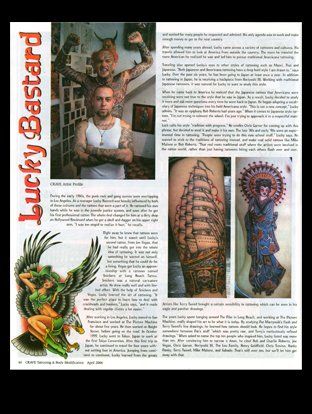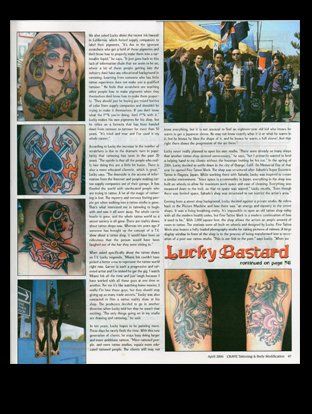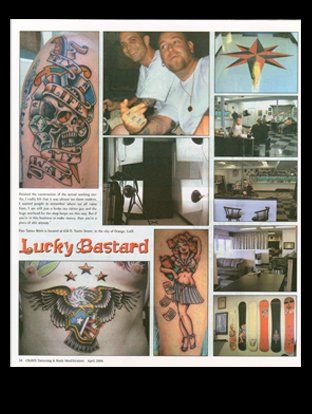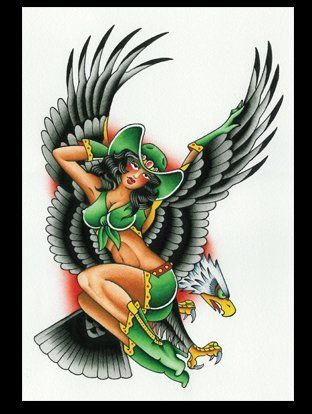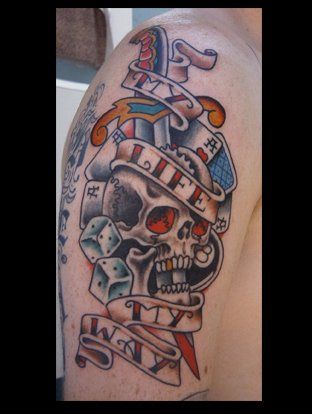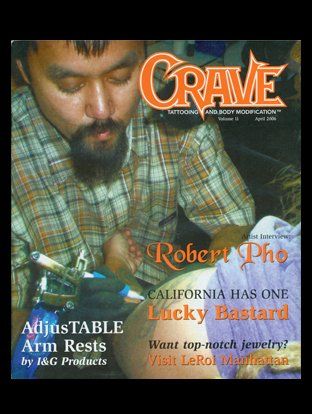
CALIFORNIA HAS ONE LUCKY BASTARD
During the early 1980’s the punk rock and gang scenes were overlapping in Los Angeles. As a teenager Lucky Bastard was heavily influenced by both of these cultures. Having mainly older friends, Lucky was exposed at an early age to tattoos because all of his friends already had them. He tattooed his own hands while he was in the juvenile justice system, but soon after, he got his first professional tattoo. The whole deal changed for him at a dirty shop on Hollywood Boulevard when he got a skull and dagger on his upper right arm. “I was too stupid to realize it hurt,” he recalls. Right away he knew that tattoos were for him, but at this time did not know to what extent.
It wasn’t until Lucky’s second tattoo, from Joe Vegas, that he had really got into the whole idea of tattooing. It was not only something he wanted on himself, but something that he could do for a living. Vegas got Lucky an apprenticeship with a tattooer named Snickers at Long Beach Tattoo. Snickers was a natural caricature artist. He drew really well and with limited effort. With the help of Snickers and Vegas, Lucky learned the art of tattooing. “It was the perfect place to learn how to deal with crackheads and hookers,” Lucky says, “and it made dealing with regular clients a lot easier.”
After working in Los Angeles, Lucky moved to San Francisco and worked at The Picture Machine for about five years. He then worked on Haight Street, before going on the road. In October 1999, Lucky went to Tokyo, Japan to work at the first Tokyo Convention. After this first trip to Japan, he continued to travel for four years without setting foot in America. Jumping from continent to continent, Lucky learned from the greats and worked for many people he respected and admired. His only agenda was to work and make enough money to get to the next country.
After spending many years abroad, Lucky came across a variety of tattooers and cultures. His travels allowed him to look at America from outside the country. The more he traveled the more American he realized he was. This realization lead him to pursue traditional Americana tattooing.
Traveling also opened Lucky’s eyes to other styles of tattooing such as Maori, Thai, and Japanese. Both Japanese and Americana tattooing have a deep bold style that Lucky is drawn to. Over the past six years, he has been going to Japan at least once a year. In addition to tattooing in Japan, he is receiving a backpiece from Horiyoshi III. Working with traditional Japanese tattooers, it was natural for Lucky to want to study this style.
When he came back to America he noticed that the Japanese tattoos that Americans were receiving were not true to the style that he saw in Japan. As a result, Lucky decided to study it more and ask more questions every time he went back to Japan. He began adapting a vocabulary of Japanese techniques into his bold Americana style. “This is not a new concept,” Lucky admits. “It was an epiphany Bob Roberts had years ago.” When it comes to Japanese style tattoos, “I’m not trying to reinvent the wheel. I’m just trying to approach it in a respectful manner.”
When asked to classify his style of tattooing, he calls it “tradition with progress.” He credits Chris Garver for coming up with this phrase, but decided to steal it and make it his own. The late 80’s and early 90’s were an experimental time in tattooing. “People were trying to do this new school stuff,” Lucky says. He wanted to stick to the traditions of tattooing instead, and make real solid tattoos like Mike Malone or Bob Roberts. “That real roots traditional stuff where the artists were involved in the tattoo world, rather than just having tattooers biting each others flash over and over. Artists like Terry Tweed brought a certain sensibility to tattooing which can be seen in his eagle and panther drawings.” This is the kind of craftsmanship that initially attracted Lucky to tattooing.
The years Lucky spent hanging around The Pike in Long Beach, and working at The Picture Machine, really shaped his art to be what it is today. By studying Pat Martynuik’s flash and Terry Tweed’s line drawings, he learned how tattoos should look. He hopes to find his style somewhere between Pat’s stuff “which was pretty raw, and Terry’s meticulously refined drawings.” When asked to name the top ten people who inspired him, Lucky listed way more than ten. After convincing him to narrow it down, he sited Bob and Charlie Roberts, Joe Vegas, Chris Garver, Horiyoshi III, The Leu Family, Henry Goldfield, Chris Trevino, Hanky Panky, Terry Tweed, Mike Malone, and Sabado. That’s still over ten, but we’ll let him get away with that.
We also asked Lucky about the recent ink lawsuit in California, which forced supply companies to label their pigments. “It’s due to the ignorant scratchers who get a hold of these pigments and don’t know how to properly make them into a tattooable liquid,” he says. “It just goes back to this lack of information chain that we seem to be on, where a lot of these people getting into the industry don’t have any educational background in tattooing. Learning from someone who has little tattoo experience does not make you a qualified tattooer.” He feels that scratchers are teaching other people how to make pigments when they themselves don’t know how to make them properly. “They should just be buying pre-mixed bottles of color from supply companies and shouldn’t be trying to make it themselves. If you don’t know what the fuck you’re doing, don’t fuck with it.” Lucky makes his own pigments for his shop, but he relies on a formula that has been handed down from tattooer to tattooer for more than fifty years. “It’s tried and true and I’ve used it my whole career.”
According to Lucky the increase in the number of scratchers is due to the dramatic turn in popularity that tattooing has seen in the past twenty years. “The upside is that all the people who really love doing this are a little bit busier. There is also a more educated clientele, which is great,” Lucky says. “The downside is the access of information from the Internet and people making tattoo supply companies out of their garage. It has flooded the world with uneducated people who are trying to tattoo. A lot of the magic of tattooing is lost. The mystery and nervous feeling people get when walking into a tattoo studio is gone. That’s what interested me in tattooing to begin with and now it all went away. The whole carnie hustle is gone, and the whole tattoo world as a secret society is all gone. There are reality shows about tattoo shops now. Whereas ten years ago if someone has brought up the concept of a T.V. show about a tattoo shop, it would have been so ridiculous that the person would have been laughed out of the bar they were sitting in.” When asked specifically about the tattoo shows on T.V. Lucky responds, “Miami Ink couldn’t have picked a better crew to represent the tattoo world right now. Garver is such a progressive and talented artist and I’m stoked he got the gig. I watch Miami Ink all the time and just laugh because I have worked with all those guys at one time or another. For me it’s like watching home movies. I really fuckin love those guys, but they should stop giving up so many trade secrets.” Lucky was also contacted to film a tattoo reality show at his shop. The producers decided to go in another direction when Lucky told her that he wasn’t that exciting. “The only things going on in my studio are drawing and tattooing,” he said.
In ten years, Lucky hopes to be painting more. These days he rarely finds the time. With this new generation of clients, he stays busy doing larger and more ambitious tattoos. “More tattooed people, and more tattoo studios, equals more educated tattooed people. The clients still may not know everything, but it is not unusual to find an eighteen-year old kid who knows he wants to get a Japanese sleeve. He may not know exactly what it is or what he wants in it, but he knows he likes the shape of it, and he knows he wants a full sleeve! And that right there shows the progression of the art form.”
Lucky never really planned to open his own studio. “There were already so many shops that another tattoo shop seemed unnecessary,” he says, “but I primarily wanted to lend a helping hand to my clients without the bossman looking for his cut.” In the spring of 2004, Lucky decided to settle down in the city of Orange, California. On Memorial Day of that year he opened Fine Tattoo Work. The shop was structured after Sabado’s Super Eccentric Tattoo in Nagoya, Japan. While working there with Sabado, Lucky was inspired to create a similar environment. “Since space is a commodity in Japan, everything in the shop was built on wheels to allow for maximum work space and ease of cleaning. Everything was measured down to the inch, so that no space was wasted,” Lucky recalls. “Even though there was limited space, Sabado’s shop was structured to not restrict the artist’s area.”
Coming from a street shop background, Lucky decided against a private studio. He refers back to the Picture Machine and how there was “an energy and mystery in the street shops. It was a living breathing entity. It’s impossible to open an old tattoo shop today with all the modern health codes, but Fine Tattoo Work is a modern continuation of how it used to be.” With 3,000 square feet, the shop allows the artists an ample amount of room to tattoo. The stations were all built on wheels and designed by Lucky. Fine Tattoo Work also boasts a fully loaded photography studio for taking pictures of tattoos. A large display window in front of the shop is in the process of being transformed into a recreation of a post war tattoo studio. “This is our link to the past,” says Lucky. “When we finished the construction of the actual working studio, I really felt that it was almost too damn modern. I wanted people to remember where we all came from. I am still just a broke ass tattoo guy and the huge over head for the shop keeps me this way. But if you’re in this business to make money, then you’re a piece of shit anyway.”
Fine Tattoo Work is located at 745 W Chapman Ave, in the city of Orange, California.

